You and your agency team can be great at getting things done and handling any kind of SEO and marketing tasks. However, applying your SEO and marketing skills to everyday tasks is not the same as marketing them to others — and this is where many marketers can come unstuck.
So, what matters most to the potential client in a sales pitch?
To find out, we gathered the opinions of over 200 agency and in-house marketers and conducted an extensive study identifying 10 elements of a winning agency pitch deck. Here, we’ll cover the highlights of what we found (you can explore the full study in more detail via the link).
A Winning Pitch: Agency vs. Brand Vision
We have a lot of agencies and freelancers among our users and we know their pains. Almost half of them (47%) say lack of new sales is the main issue preventing their growth. 29% of agencies think the top challenge for them is differentiating themselves from other marketing firms.
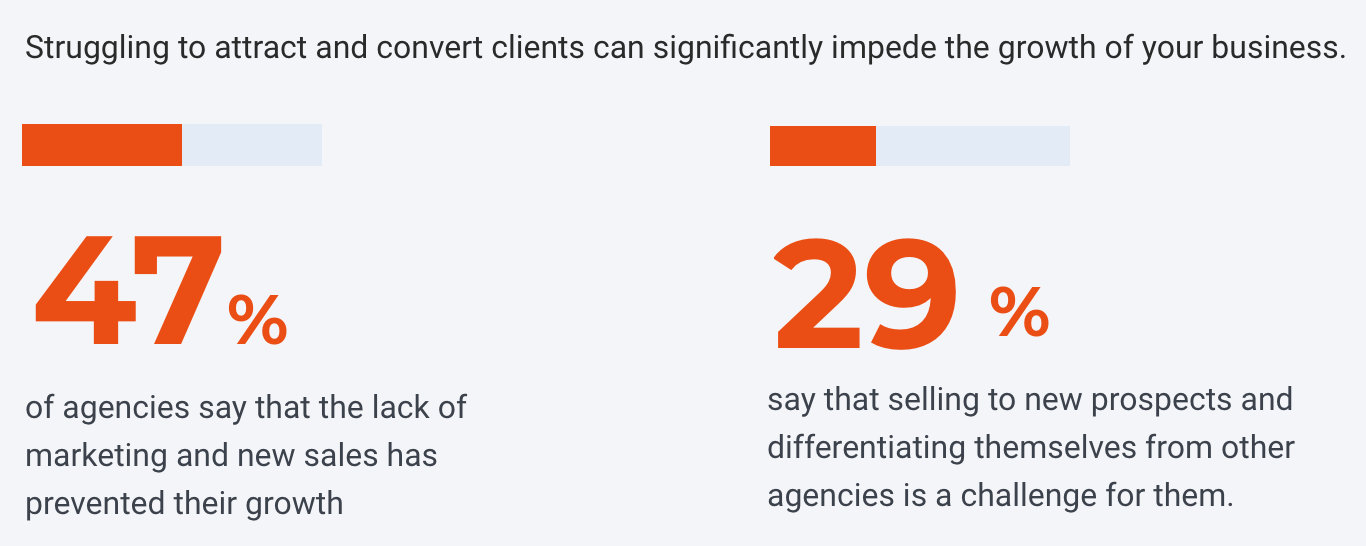
To help agencies sell faster and more effectively, we conducted an extensive study, reaching out to over 200 agencies, freelancers and in-house marketers. As a result, we found out what really matters in a successful agency pitch — and dissected some fundamental differences in agency vs. brand vision.

As you can see, the five most controversial elements of a sales pitch are:
Underrated: Transparent pricing model Underrated: Client-tailored strategy proposal Underrated: Clear description of working processes Overrated: Clear value proposition Overrated: Case studiesLet’s look at each of these in more detail.
1. Underrated: Transparent Pricing Model
Importance: 51/100 for brands, 34/100 for agencies
Only 34% of agencies see transparent pricing as an important factor. This likely happens because approaching money-related questions seems quite risky for agencies, especially during a pitch meeting. However, Jake Third, Managing Director at Hallam, suggests looking at it from a different angle:
“Don’t worry about upsetting your customer because you’re making a profit. They want your business to succeed and to have a long-term relationship, and that means profit isn’t a dirty word.”
Jake Third, Managing Director at Hallam
Here’s what you can do to take the heat off this sensitive yet very important question.
Action points:
State clearly what pricing model will be used
The most popular pricing models are:
Retainer Project-based Hourly rate Commission Value- or Performance-basedMany agencies use different models depending on the project:
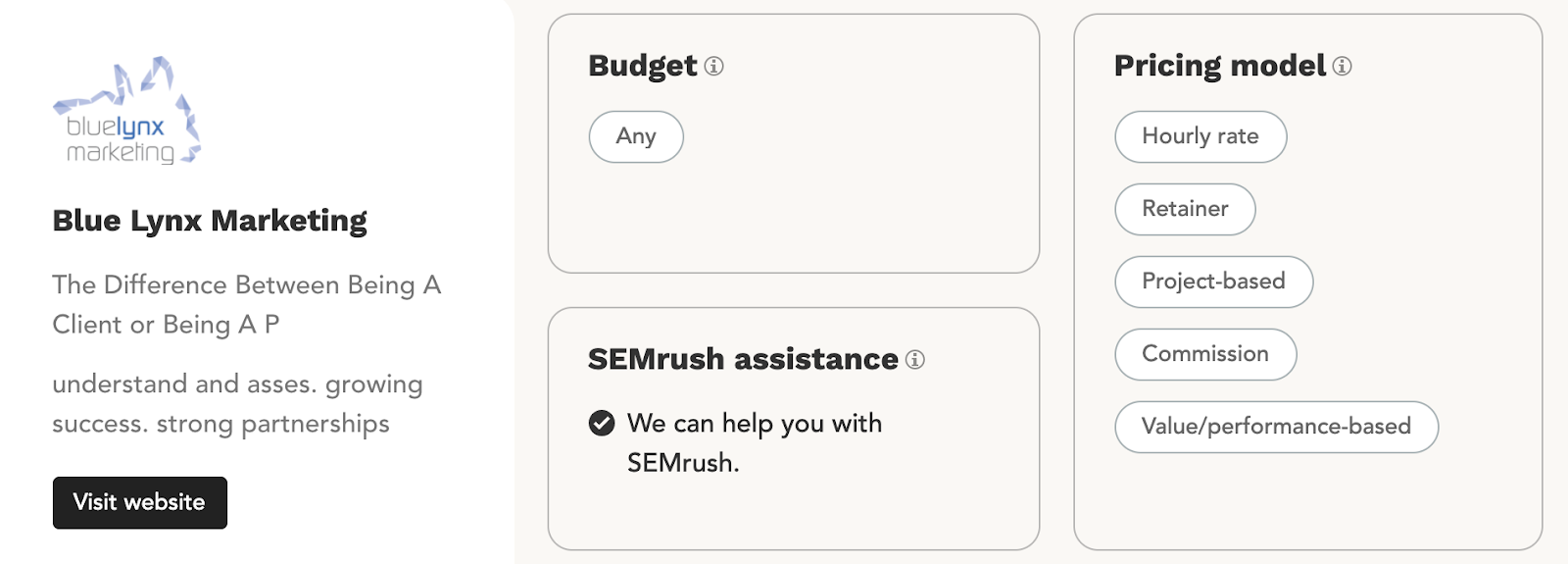
If you do too, explain why you stick to this particular model for this particular client — and how it will benefit both sides.
Highlight what is given for free
While working on a project, agencies do a lot of behind-the-scenes tasks. Each of these — be it setting up the analytics, conducting a technical audit, or developing a UX analysis — would have a separate price if the client reached out to an external firm. Don’t forget to mention these services in the “What you get for free” part of your pitch.
As a bonus, agencies can provide access to paid tools and platforms you won’t need to pay for. When it comes to Semrush, you can get access to your personal project to track dozens of metrics you won’t find in free tools — for example, your daily rankings and search visibility compared to competitors:

2. Underrated: Client-Tailored Strategy Proposal
Importance: 74/100 for brands, 64/100 for agencies
74% of brands (and only 64% of agencies) rated the client-tailored proposal as a key element of an agency slide deck. On the brand side, they want you to speak about their specific case, offer a solution to their specific problem, and provide a strategy that will help them achieve their business targets.
Action points:
Use an easy-to-understand visual concept. Spreadsheets are inevitable when you get down to work, but at the pitch stage turning a boring table into a compelling visual will definitely help.
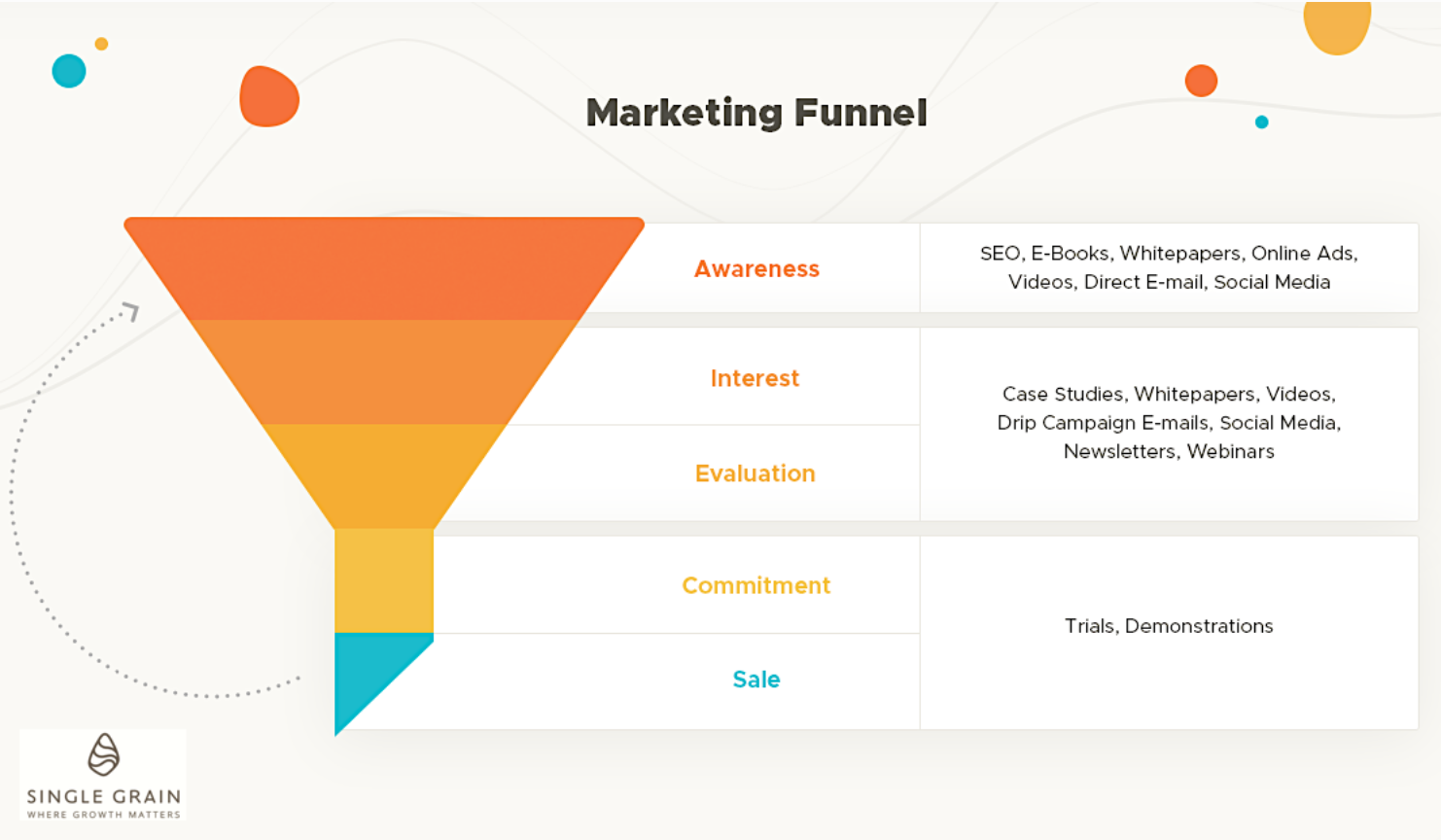 Source: singlegrain.com
Source: singlegrain.com Mix strategy with granular ideas. “We will use Facebook Ads at the awareness stage” sounds good, but if you also offer some creatives tailored to a specific audience (you can get some inspiration from the Inverted Unicorn Ad Targeting Strategy by Larry Kim), it will make the complete picture much more colorful.
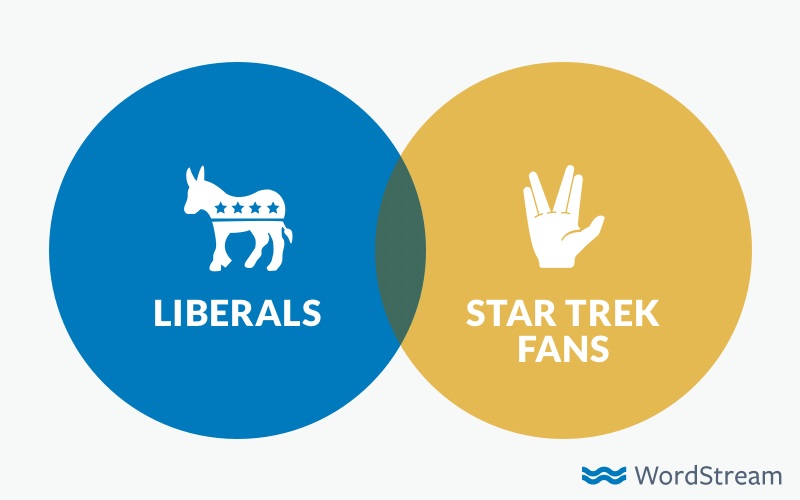
Focus on business goals. If you’re dealing with a task like “create a new website design” or “increase Facebook followers by 300%”, identify what the main goal behind it is. Is it about increasing the conversion rate of the website? Or is it about getting more orders from social media organically without having to spend more on aggressive outbound tactics? When you have the answer, you’ll be much more comfortable building a step-by-step strategy to achieve the goal.
3. Underrated: Clear Description of Working Processes
Importance: 67/100 for brands, 58/100 for agencies
Rated the second-most important factor by brands (even higher than price — see the complete breakdown in the full version), this is probably the result of previous negative experience the clients had with agencies. It’s not enough to show what a brand can achieve with the agency’s support — it’s also essential to show how it’s going to be done.
Action points:
Visualize the process as a timeline
This will help answer questions like “Why don’t we see any traffic yet?” and “When will you start posting new content?” Don’t forget to include:
Timeframe — how long each task is going to take Input — what is needed from each side (you’ll need access to social accounts to post and launch ads, etc.) Definition of ‘done’Here’s what a timeline could look like (the timeframes are given as examples!)
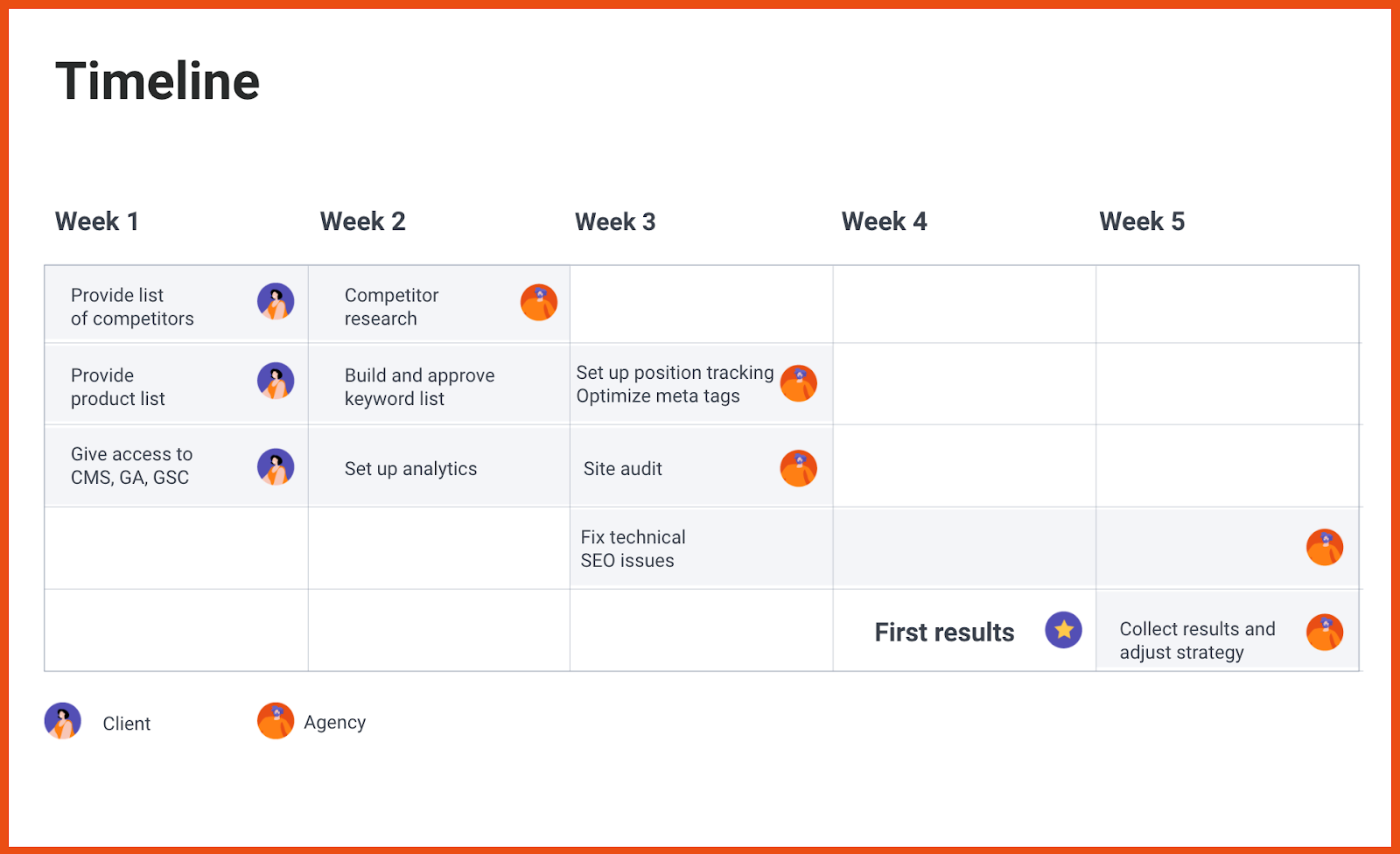
Hannah Thorpe, Business Director at Found, also emphasizes the necessity of telling how much effort is needed from the client side:
Whilst it’s important for the client to know how we do this, it’s also key that they understand how much time they’ll need to invest upfront to make the most out of our relationship. If we call this out at the onboarding stage, it enables clients to know which stakeholders to prepare e.g. we often want to talk to clients’ sales teams or customer services to understand the challenges.
Hannah Thorpe, Business Director at Found
4. Overrated: Clear Value Proposition
Importance: 38/100 for brands, 66/100 for agencies
The role of clear positioning and a “bold statement” is often overrated by agencies — only 38% of brands see this as an important part of the pitch process. This is probably a matter of wording — clients want to know more specifically what exact “value” the marketing agency provides. However, it’s still one of the key elements of a pitch, and here are some tips on how to hone your skills.
Action points:
Use the UVP as a starting point
If you need to prepare a pitch deck, this most probably means you’re not the only agency willing to work with the client. This is why you need to stand out from the others — and the best way to do it is to start with a concise self-introduction that differentiates your firm. This could be:
The industry you specialize in (a Cooper Westwood example): The service you’re an expert in. This is how Gareth Hoyle, Managing Director at Marketing Signals, describes the UVP of his agency:
The service you’re an expert in. This is how Gareth Hoyle, Managing Director at Marketing Signals, describes the UVP of his agency: We are experts at link building. This is our differentiator. This is what we shout about. Our storytelling is based around this activity and, ultimately, this is what the leads we attract are looking for. A successful differentiation from a large % of other agencies. By having a very narrow specialism, our UVP is easier to define than the broader, general agencies offering “SEO services”.
Gareth Hoyle, Managing Director at Marketing Signals
Or just something personal and informal (a Raincross example)
5. Overrated: Case Studies
Importance: 16/100 for brands, 47/100 for agencies
Another big discrepancy in agency vs. brand vision of a good pitch: agencies put case studies among the top five factors (47%), while only 16% of brand representatives say “past merits” are important.
Examples of previous projects look like a good addition to the whole picture, but not like a crucial factor in decision making. Yet, one brand out of five will look at your past performance, which means your chances of meeting one of these prospective clients are quite high.
Action points:
Link to real examples. Aleksei Kudimov, CEO at Direct Line, says showing success stories allows him to define more clearly the value of their services.
“Whenever you can, show the ‘hard evidence’ of your work. Share links to real websites so that the prospect can evaluate the speed, mobile responsiveness, the quality of SEO, etc.”
Aleksei Kudimov, CEO at DirectLine
Consider putting these slides at the end of your pitch presentation. This will naturally sound like an additional reason to choose you over the others, but not like the main one, because you understand that each client’s case is unique.
Over to You
A one-size-fits-all presentation template doesn’t exist. With our study, we identified what are the most common traits of a good deck and what clients really look at when choosing an agency. But in every single case, something different can trigger the final “yes” from the client. So we’re looking for more insights from you!
What made you choose your agency if you’re an in-house team representative?
What was your most successful pitch if you’re on the agency side?
Share your experience in the comments.
Innovative SEO services
SEO is a patience game; no secret there. We`ll work with you to develop a Search strategy focused on producing increased traffic rankings in as early as 3-months.
A proven Allinclusive. SEO services for measuring, executing, and optimizing for Search Engine success. We say what we do and do what we say.
Our company as Semrush Agency Partner has designed a search engine optimization service that is both ethical and result-driven. We use the latest tools, strategies, and trends to help you move up in the search engines for the right keywords to get noticed by the right audience.
Today, you can schedule a Discovery call with us about your company needs.
Source:


![The Most Overrated and Underrated Elements of an Agency Pitch Deck [Semrush Study]](https://allinclusive.agency/uploads/images/the-most-overrated-and-underrated-elements-of-an-agency-pitch-deck-semrush-study.svg)


